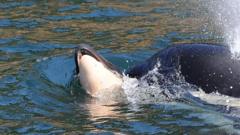A familiar image of sorrow has re-emerged in the waters off Washington state's coast, as Tahlequah, a Southern Resident killer whale, has once again been observed pushing the body of her deceased calf. This heart-wrenching scene recalls the global attention garnered when the orca, also designated as Whale J35, was seen grieving for a remarkable 17 days after the loss of her newborn in 2018.
The Center for Whale Research has confirmed this latest sighting, describing the loss as "particularly devastating" given Tahlequah's already challenging history. Out of her four documented calves, two have now sadly passed away, both of which were female. The mortality of any calf represents a significant setback to the population’s survival, particularly as both Canada and the United States classify Southern Resident killer whales as endangered species.
The decline of the Chinook salmon, the primary food source for these magnificent creatures, has been notable in recent years. Researchers from the University of Washington have highlighted that the reproductive failures in this population are closely linked to nutritional shortages and access to these essential fish.
In addition to being emotionally affected by the losses, the Southern Resident killer whales, including Tahlequah, have demonstrated remarkable resilience, frequently traveling as much as 120 kilometers (75 miles) a day across their foraging grounds.
As the plight of these whales continues to gain exposure, the focus on conservation efforts becomes more urgent to address the dual crises of declining population and diminishing food sources contributing to such tragic outcomes.






















